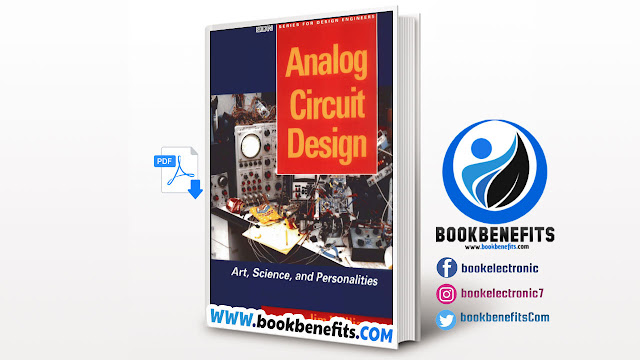Download Analog Circuit Design - Analog Devices PDF
Analog Circuit Design - Analog Devices PDF
Picture Of The Book :
About Of The Book :
Most books have a single introduction. This one has four. Why? Analog circuit design is a very “personalized” discipline. To be sure, everyone’s bound by the same physics and mathematics, but there’s no single “right way” for those tools to be applied to solve a problem. Practitioners of analog design are noted for their individuality. Three of the four introductions that follow are by acknowledged masters of analog art and deal with analog’s place in a world that seems overwhelmed by digital electronics. Each of those three authors gives a highly personal viewpoint that can’t be objectively proven “right” or “wrong,” but that’s the way it is in many aspects of analog design. The remaining introduction, which appears first, doesn’t directly deal with analog electronics at all. However, it does illustrate the “matrix of thought’‘ that so many successful analog designers bring to their efforts. is a way of looking at things. Dr. Calandra’s thoughts originally appeared in the January 1970 issue of “The Lightning Empiricist,” then published by Teledyne Philbrick Nexus, and is reprinted by permission of Teledyne Corporation. We don’t know if the student described ever became interested in analog electronics, but he clearly had all the necessary attributes of a good analog design engineer. The name of George Philbrick will be invoked several times in this book, and in each instance some awe and reverence are noticeable. This is because if the contemporary analog design has a founding father, it would have to be George Philbrick. Many of the top names in the field today either worked under or were influenced by him. Although he passed away several years ago, his wisdom is still relevant to many current situations. Here’s a sample from the October 1963 issue of “The Lightning Empiricist,” published by the company he founded, Teledyne Philbrick. We’re grateful for the company’s kind permission to reprint the following since it’s difficult to imagine a real guide to analog design without George Philbrick! Let’s face it: analog electronics aren’t very sexy these days. The announcement of a new microprocessor or high-capacity DRAM is what makes headlines in the industry and business press; no one seems to care about new precision op amps or voltage-to-frequency converters. Sometimes it seems as if digital electronics is the only place in electronics where anything’s going on. Not so, says Jim Williams, as he tells why analog electronics is more than still important-it’s unavoidable. Dan Sheingold’s essay originated as a letter to the editor of Electronic Engineering Il-times. In its original form (with a slightly different message); it appeared on December 4: 1989. Often electronics engineers draw clear distinctions between “analog electronics” and “digital electronics.” implying clear barriers between the two disciplines that only the very brave (or very foolish) dare cross. However, as Dan points out, the differences between them might not be quite what we think. Introductions are normally read before the rest of the book, and so should these. But you might want to return and read them again after you’ve finished this book. It’s likely that you might have a different reaction to them then than the one you’ll have now.
Contents Of The Book :
ne Introduction
1. Barometers and Analog Design
2. Analogs Yesterday, Today, and Tomorrow, or Alexander Calandra
Metaphors of the Continuum
George A. Philbrick
Dan Sheingold
Jim Williams
3. It's An Analog World-Or Is it?
4. Is Analog Circuit Design Dead?
5. On Being the Machine
6. Reflections of a Dinosaur
7. Max Wien, Mr. Hewlett, and a Rainy Sunday Afternoon
Bernard Gordon
Samuel Wilensky
Jim Williams
Three The Making of an Analog Engineer
8. True Analog Circuit Design
9. The Story of the P2 (The First Successful Solid-state Operational
Tom Hornak
Amplifier With Picoampere Input Currents)
Bob Pease
10. Propagation of the Race (of Analog Circuit Designers) 79
11. The Process of Analog Design 89
12. Analog Design Discipline: A Tale of Three Diodes 93
13. Should Ohm's Law Be Repealed? 99
Jim Roberge
Rod Russell
Milton Wilcox
Jim Williams
Four Intuitions and Insights
14. Good Engineering and Fast Vertical Amplifiers
15. Understanding Why Things Don't Work
16. Building Blocks for the Linear IC Designer:
Linear Synthesis for Monolithic Circuits
John Addis
Bob Blauschild
A. Paul Brokaw
17. How to Design Analog Circuits Without a Computer
or a Lot of Paper
18. Starting to Like Electronics in Your Twenties
19. Where Do Little Circuits Come From?
20. The Process of Analog Design
21. The Art of Good Analog Circuit Design-Some Basic Problems
Richard S. Burwen
George Erdi
Barrie Gilbert
Garry Gillette
and Possible Solutions
Barry Hilton
22. My Approach to Feedback Loop Design
23. The Zoo Circuit: History, Mistakes, and Some Monkeys Design a Circuit
Phil Perkins
Jim Williams
Five Techniques, Tips, and Applications
24. Reality-Driven Analog Integrated Circuit Design
25. Current-Feedback Amplifiers
26. Analog Extensions of Digital Time and Derek F. Bowers
Sergio Franco
Frequency Generation
Garry Gillette
27. Some Practical Aspects of SPICE Modeling for Analog Circuits
E. J. Kennedy
Robert f. Matthys
28. Design of Crystal Oscillator Circuits
29. A Tale of Voltage-to-Frequency Converters (Ancient History)
Rob Pease
30. Op Amps and Their Characteristics
Information Of The Book :
Title: Analog Circuit Design - Analog Devices Download PDF
Language: English
Size: 22.33 MB
Year : 2003
Pages: 410
Format: PDF
Author: Jim Williams

